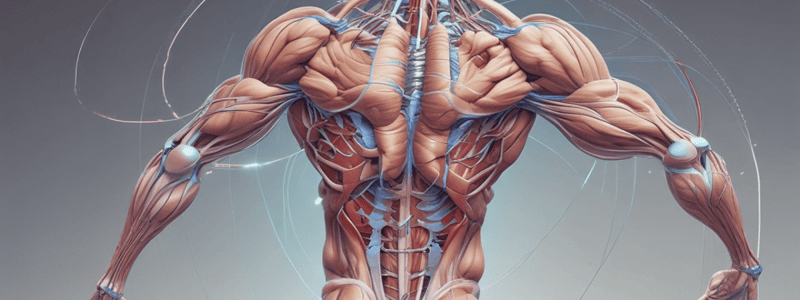Podcast
Questions and Answers
What is the result of the action potential from nerves connecting to the muscles at the motor endplate?
What is the result of the action potential from nerves connecting to the muscles at the motor endplate?
- Release of Ca+2 from the Sarcoplasmic Reticulum (correct)
- Excitation of the muscle cell
- Formation of cross-bridges between myosin and actin
- Release of acetylcholine at the neuromuscular junction
What is the primary function of the motor unit?
What is the primary function of the motor unit?
- To regulate the relaxation of muscles
- To facilitate the contraction of antagonistic muscles
- To transmit the action potential from the nerve to the muscle fibers (correct)
- To control the formation of cross-bridges between myosin and actin
What is the term for the process by which the excitation of the muscle cell is coupled to contraction of the muscle?
What is the term for the process by which the excitation of the muscle cell is coupled to contraction of the muscle?
- Muscle contraction cycle
- Myofibril activation
- Excitation-contraction coupling (correct)
- Cross-bridge formation
Which of the following is NOT a characteristic of smooth muscle?
Which of the following is NOT a characteristic of smooth muscle?
What is the term for the muscle contraction that causes a bending movement?
What is the term for the muscle contraction that causes a bending movement?
What is the term for the muscles that contract to provide the main force to move or rotate a bone through its joint?
What is the term for the muscles that contract to provide the main force to move or rotate a bone through its joint?
What is the primary factor that determines the force generated by a muscle?
What is the primary factor that determines the force generated by a muscle?
What type of muscle contraction occurs when the force applied to the muscle exceeds the force produced by the muscle?
What type of muscle contraction occurs when the force applied to the muscle exceeds the force produced by the muscle?
What is the relationship between muscle contraction speed and muscle power?
What is the relationship between muscle contraction speed and muscle power?
What is the effect of muscle length on muscle contraction?
What is the effect of muscle length on muscle contraction?
What is an example of an isometric contraction?
What is an example of an isometric contraction?
What is the primary function of muscles in the musculoskeletal system?
What is the primary function of muscles in the musculoskeletal system?
Which of the following is NOT a type of muscle fiber?
Which of the following is NOT a type of muscle fiber?
What is the structure that attaches to the thin filaments in a myofibril?
What is the structure that attaches to the thin filaments in a myofibril?
What is the result of the hydrolysis of ATP to ADP during muscle contraction?
What is the result of the hydrolysis of ATP to ADP during muscle contraction?
What is the functional unit of muscle contraction, comprising a motor neuron and the muscle fibers it innervates?
What is the functional unit of muscle contraction, comprising a motor neuron and the muscle fibers it innervates?
What is the term for the area between two consecutive Z-discs in a myofibril?
What is the term for the area between two consecutive Z-discs in a myofibril?
Flashcards are hidden until you start studying
Study Notes
Musculoskeletal System
- The musculoskeletal system is composed of bones, joints, muscles, cartilage, tendons, ligaments, and other connective tissue.
- Its primary functions are to support the body, allow motion, and protect internal organs.
Muscles
- The purpose of muscles is to move the body and convert chemical energy into mechanical energy (ATP to force).
- Muscle fibers contain contractile proteins: actin and myosin.
- There are three types of muscles: skeletal, cardiac, and smooth.
Muscle Organization
- Individual muscles are made up of muscle bundles.
- Muscle bundles are made up of muscle fibers.
- Muscle fibers are made up of myofibrils.
- Myofibrils are organized into sarcomeres, the contractile unit of the muscle.
Sliding Filament Model
- The myosin head binds ATP and detaches from actin.
- Hydrolysis of ATP to ADP results in a conformational change in the myosin head.
- The myosin head binds to actin, forming a cross-bridge.
- The myosin head releases ADP and Pi, resulting in another conformational change, called the power stroke.
Motor Unit
- A motor unit is a motor neuron and all of the muscle fibers that connect to it.
- An action potential from nerves connects to the muscles at the motor endplate.
- This causes the sarcoplasmic reticulum to release Ca+2, which binds with troponin, exposing actin binding sites.
Muscle Contractions
- Muscles are arranged in pairs, with antagonist muscles causing opposite movements.
- Agonist muscles contract to provide the main force to move or rotate a bone through its joint.
- Muscle length affects the actin-myosin overlap and the force that can be generated.
- Maximizing the number of cross-bridges formed maximizes muscle power (force).
- Muscle contraction speed relates to muscle power (force).
- Isometric contraction occurs when the muscle does not change length.
- Lengthening contraction occurs when the force applied to the muscle exceeds the force produced by the muscle.
Studying That Suits You
Use AI to generate personalized quizzes and flashcards to suit your learning preferences.




